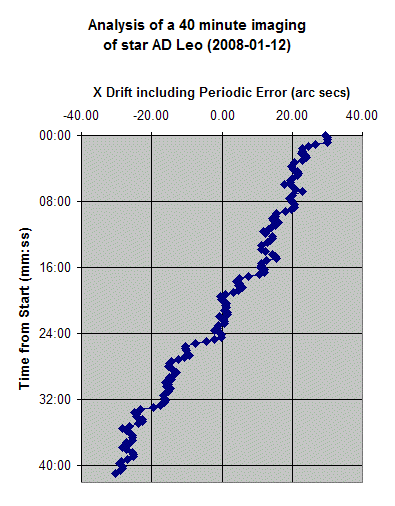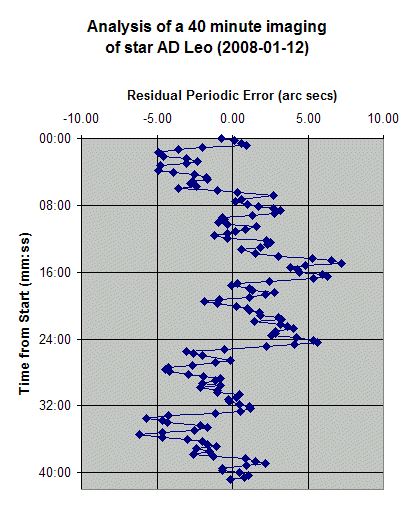David's Astronomy Pages
|
Notes (S240) |
Notes (Main) |
Home Page |
Notes (S266) |
|
Polar Alignment Adjustment (2008-01-11) Polar Alignment Results (Alignment worsened) - AD Leo Periodic Error check (AD Leo) >
Based on previous TPoint Mapping (Mapping Run on 2007-12-07) a polar misalignment existed in the telescope mount. The indicated amount of misalignment varied with precisely which additional terms were included in the TPoint model, however the best view seemed to suggest a 9.0 arc min counterclockwise adjustment of the mount to point the polar axis further west and a 3 arc min wedge adjustment to raise the polar axis.
At the beginning of session 252, the polar alignment was adjusted by the above amounts using the method described in session 211 (CCD Assisted Polar Alignment Correction). The alignment corrections were made without incident and subsequent analysis of the check images confirms that the intended adjustments were made. Real-time observations and later analysis of images collected later in the session showed however that polar alignment had noticeably worsened (see below).
Back to Top
At the beginning of session 252, the polar alignment was adjusted by the amounts described above. Although the adjustments amounts were thought suitable, real-time observations and subsequent analysis of images collected later in the session showed that polar alignment had actually worsened noticeably with star trailing in exposures of 60-120 sec, and with significant movements over the course of a 15 minute sequence of 2 - 3 minute subs and during long sequences of 10s exposures, for example during a 40 minute imaging run of AD Leo, the star was found to move nearly 1 arc minute.
|
AD Leo (Leo) |
|
|
|
CCD Image |

It would seem that either the Polar alignment information from TPoint Mapping Models of 2007-12-07 had been misleading or that the mount had somehow moved since. The latter is considered unlikely. More likely is that either tube flexure and/or sag caused by the heavy SBIG ST7 CCD camera/filter wheel had affected the accuracy of the MA/ME Polar alignment terms.
Subsequent analysis on 2008-01-17 using the Drift Method showed that the polar axis was now pointing too far west, and indicated that the mount needed to be rotated clockwise by 6.2 arc min. (suggesting that the original movement should have been a 2.8 arc min counterclockwise rotation not the 9 arc min rotation that TPoint had suggested).
Back to Top
Although not ideal for checking Periodic Error, due to the high rate of star drift (~1.4 arc sec/minute) , some indication of periodic error was backed out from the 40 minute imaging run of star AD Leo (see above), by subtracting the average rate of star drift over the 40 minute run.
Periodic error appears to be +/- 3.5 arc secs, but there appears also to be non regular error, which is increasing overall error to around +/- 6 arc min over longer periods than the normal 8 minute period

Periodic error is larger than when measured after training in 2004-12-07 (2.5 arc secs). It is probable that the previous PEC dataset was lost when the internal battery in LX200 was replaced in late 2007 or has otherwise been erased. Alternatively it may also represent a failing in the LX200 control/handset as the telescope is not longer able to retain calendar date values when turned off (though other settings eg. location, are retained).
During session 254 a PEC training run was
conducted using a star lying close to the meridian at approximately declination
= 0 deg.
This comprised an initial 8 minute "learn" run, followed by two 8
minute "update" runs. Guiding was performed using CCDSoft
autoguiding.
First run used 2s exposures, whilst 2nd and 3rd runs used 1s exposures. An
initial autoguide aggressive value of 10 was used, but was lowered to a value of
8 for the last update run. The results of this PEC training will be
examined in a later session, as cloud prevented a intended post training QC
check
Back to Top
| This Web Page: | Notes - Session 252 (2008-01-11) |
| Last Updated : | 2015-05-16 |
| Site Owner : | David Richards |
| Home Page : | David's Astronomy Web Site |